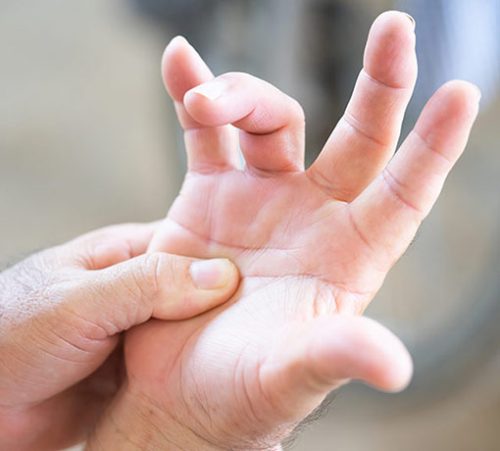Understanding Trigger Finger with Advanced Dermatology, PC
Imagine a world where the flexing and extension of your fingers becomes arduous, where each movement is marked by discomfort and hesitation. This is the world of trigger finger, a condition that affects countless individuals, young and old, interrupting simple, seamless hand movements.
Trigger finger, also known as stenosing tenosynovitis, is a condition that affects the fingers and can cause discomfort and limited mobility.
It occurs when the tendons that control the movement of your fingers become inflamed or swollen, leading to various painful symptoms.
If you or a loved one are experiencing symptoms of trigger finger, our experienced team at Advanced Dermatology, PC, is here to help.
Continue reading to learn more about trigger finger, including important information on how to unlock trigger finger.


Trigger Finger Symptoms and Diagnosis
Trigger finger is a medical dermatology condition that happens when the tendon sheath in one or more fingers becomes inflamed.
Signs and symptoms can be mild to severe and may include:
- Inability to straighten the finger or thumb.
- Popping or clicking sound when moving the finger or thumb.
- Finger locking in a bent position, which may release after some time.
- Finger stiffness and pain at the bottom of the finger or thumb when moved or pressure is placed on it.
Diagnosing trigger finger involves a thorough process that begins with a medical evaluation and a detailed medical history. Your healthcare provider will inquire about your symptoms, duration, and prior hand or finger injuries. They will also assess your medical history, paying attention to conditions like diabetes or rheumatoid arthritis, which can increase the risk of a trigger finger.
During your physical examination, your healthcare provider will closely examine your hand and fingers for visible signs of swelling or nodules. They will also evaluate the range of motion in your affected finger(s). An essential symptom of the trigger finger is the sensation of the finger getting stuck in a bent position and then suddenly snapping straight with an audible “click.”
To rule out other potential conditions, a differential diagnosis may be conducted. This ensures that the symptoms are specific to the trigger finger and unrelated to other hand or finger conditions, such as tendonitis, osteoarthritis, or carpal tunnel syndrome.
In some cases, medical imaging may be recommended. X-rays can provide a more detailed view of the affected tendon and surrounding structures, confirming the diagnosis.
Once the diagnosis is confirmed, your healthcare provider will discuss how to fix a trigger finger with you, which may include trigger finger surgery or other alternative options depending on the severity of your symptoms.
Trigger Finger Causes and Risk Factors
Trigger fingers can be attributed to a variety of causes and risk factors. Understanding these factors is essential for recognizing and preventing this condition.
The most common causes and risk factors include:
- Repetitive Finger Movements: Consistent, repetitive finger movements, especially in jobs or activities involving frequent gripping, can strain finger tendons and lead to trigger fingers.
- Tight Gripping: Frequent use of tools or equipment with forceful, tight grasping motions increases the risk of trigger finger development.
- Certain Medical Conditions: Conditions like rheumatoid arthritis are linked to an elevated risk of trigger fingers due to their effects on connective tissues and tendons.
- Genetic Factors: Some individuals may have a genetic predisposition to conditions affecting tendons, which increases their risk.
- Diabetes Implications: Diabetes is closely associated with trigger finger development. High blood sugar levels can affect tendon structure and function, making them more vulnerable to inflammation and stiffness.

Trigger Finger Treatment Options
Early intervention is critical in managing trigger finger. Addressing the condition promptly can help prevent it from worsening and reduce the likelihood of complications.
When treating the trigger finger, various options are available to alleviate discomfort and restore hand function.
Non-surgical options are often the first step in trigger finger treatment. These approaches include:
- Giving the affected finger a break from repetitive movements can reduce inflammation and alleviate symptoms.
- A trigger finger splint can help keep the affected finger straightened, reducing strain on the tendons.
- Anti-inflammatory medications, either oral or injected into the tendon sheath, can help alleviate pain and inflammation.
- Trigger finger exercises under the guidance of a physical therapist can improve finger strength and flexibility, aiding in symptom relief.
In cases where non-surgical approaches do not provide sufficient relief, surgical intervention may be necessary.
The three trigger finger hand surgery options available at Advanced Dermatology, PC in New York are
- Open surgery, whereby a small incision is made in the palm of the hand to cut the tendon sheath, creating more movement.
- In percutaneous release surgery, the surgeon inserts a needle into the bottom of the finger to cut the tendon sheath.
- Tenosynovectomy surgery, where a part of the tendon sheath is removed, allowing the finger to move freely again.
Tips to Prevent Trigger Finger
Here are some tips and recommendations for preventing trigger finger:
- Maintain ergonomic workspaces to reduce hand strain.
- Regularly stretch and exercise your fingers.
- Take short breaks to rest your hands.
- Use a neutral hand posture during activities.
- Include finger stretching in your daily routine.
- Avoid over-gripping tools or objects.
- Control conditions like diabetes and arthritis.
- Maintain [roper hydration to support tendon elasticity.
- Use adaptive devices if needed.
Proper ergonomics and minimizing repetitive finger movements are essential for preventing trigger finger. These practices alleviate finger strain, promote hand well-being, and reduce the likelihood of a trigger finger diagnosis.
Comprehensive Care for Trigger Finger Near You
Hand pain relief is possible with a comprehensive diagnosis and personalized treatment for trigger finger at Advanced Dermatology, PC.
If you or a loved one are living with unrelenting symptoms of trigger finger and need viable treatment options, we are here to help.
